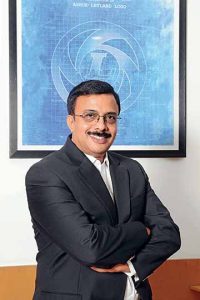Flexible tech
Q. How is the India electric vehicle story shaping up?
A. When electric vehicle movement began, it was about USD 2500 per kWh. Now it is USD 250 per kWh. When it reaches the 120 kWh level, it would be better to have electric vehicles than diesel vehicles. Battery costs are coming down. They are reducing by eight to 10 per cent every year. If that will support a smooth transition is not the point. The point is, whether the transition will happen, and when. Not only is there a policy in place, money is also being spent.
Q. What led to an association with SUN Mobility?
A. We associated with SUN Mobility for their battery swapping technology. This battery technology is truly Indian, and is designed keeping in mind the limited radius of bus routes. We looked at electric vehicle technology like everyone would. We launched the Circuit bus with fast charging. We demonstrated the capability and reliability of the technology by taking the bus up the Rohtang pass, which is considered as one of the highest motorable road. While studying the city bus market, we noticed that the operation of buses is within a certain radius. We felt that they do not need to lug a big, heavy battery. Instead, the city bus battery could be swapped the battery once it returns to the depot instead of plugging it in. The need would be to replace the battery quickly. Such an arrangement would help eliminate the necessity of a huge charging infrastructure. Looking at it as a way to achieve cost neutrality in comparison to diesel, we associated with SUN Mobility in early 2017. We decided to build a bus using swappable battery technology that meets a particular criteria. We paid particular attention to the time taken to swap a battery. It had to be less than five minutes. The first time we tested the technology, it took us an hour. We have bettered the technology, and the battery can now be swapped in two and half minutes roughly. It is faster than filling fuel.
Q. What challenges did you face to apply swappable battery technology to public transport buses?
A. Electrification would have a significant impact in a city if it were done on buses. Buses in cities are run by State Transport Undertakings (STUs). The number of buses run by private operators is much less. In a position to extend our solution to private bus operators too, the swappable battery technology would bring down the total cost of ownership in comparison to the fossil fuel based fleet in operation. Much depends upon the demand, backed by infrastructure. A bus carries approximately 30 to 40 passengers. They could even carry up to 100 passengers depending on the time of the day. In order to create a significant impact, buses or public transport is an apt segment to begin with.
Q. How smart is the battery in the scheme of things as far as the swappable battery technology is concerned?
A. Swappable battery technology supports regenerative braking as a standard feature. In that sense the battery is smart. It is small, and can accept high amount of regenerated energy keeping in mind the Indian driving conditions.
Q. What kind of swap frequency are you looking at?
A. We can design a bus based on the customer need. That could also include a solution where the battery is not swapped for a particular distance or duration of bus travel. The bus, in this case would use multiple batteries. For a pack of three, for example, there would be a need for only one battery to be swapped. We found out that 85 per cent of the routes span 30 kms so the battery is built to do 50 kms on a single charge keeping a buffer. The swappable battery technology can be extended to all platforms from nine- to 21 m. This is irrespective of it being a left-hand drive or a right-hand drive, and with air-conditioning or without air-conditioning.
Q. Who will own and operate the modular battery stations?
A. There are three models. The simplest model that we would offer is to pay as one goes (cost per kilometre). In this case, we own the entire system. We are open to offering the customer, the bus, where we take charge of the batteries. The other possible model is the one where we could handover everything to the customer and he takes complete ownership of it. We would ideally like to prioritise in the above-mentioned order since the technology is new and serves the interest of the customer in cost per kilometre. With battery technology changing, the technology that we are offering is flexible. It is flexible enough to be upgraded; to be scaled up.
Q. What are the key growth drivers for Ashok Leyland?
A. Keeping the bus business that we have spoken about aside, and in India, the commercial vehicle industry is dependent on GDP, infrastructure growth and mining. All three seem to be shaping up well. The pro-rural union budget, and the pro-infrastructure policies have brought tax rates down given all the deductions on offer contrary to popular opinion. This year has been very strong. In the coming year (FY2018-19), we expect to fare even better. The year after that (FY2019-20) will be pre-EuroVI. The year after that (FY2020-21) will be difficult but we’ll cross that bridge when the time comes. Hopefully, policies like scrappage, etc., are likely to come into effect by then, and should boost growth. It could bring with it demand worth two years. For the year (FY2017-18), we have grown by 40 to 50 per cent. Now that we have full control on LCVs, that segment for us is also shaping up well.
“With battery technology
changing, the technology that we are offering is flexible enough to be upgraded; to be scaled up”.




















